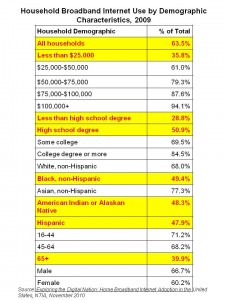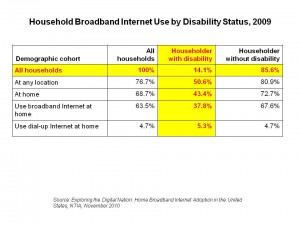 6 in 10 U.S. households connected to the Internet via broadband in 2009, rising from 9% in 2001. In the U.S., the gap in the adoption of broadband between lower-income households and higher-income people is 33% — 61% of people with $25,000 to $50,000 household income connect to the Internet at home via broadband; that proportion is 94% for households with over $100,000 a year. Adoption gaps in broadband persist in the U.S. based on income, urban/rural location, race, education, and level of disability. Differences in socio-economic and geographic characteristics explain much of the broadband adoption gap associated with disability in the U.S.
6 in 10 U.S. households connected to the Internet via broadband in 2009, rising from 9% in 2001. In the U.S., the gap in the adoption of broadband between lower-income households and higher-income people is 33% — 61% of people with $25,000 to $50,000 household income connect to the Internet at home via broadband; that proportion is 94% for households with over $100,000 a year. Adoption gaps in broadband persist in the U.S. based on income, urban/rural location, race, education, and level of disability. Differences in socio-economic and geographic characteristics explain much of the broadband adoption gap associated with disability in the U.S.
These latest statistics on U.S. broadband Internet adoption come out of the report, Exploring the Digital Nation: Home Broadband Internet Adoption in the United States, published by the National Telecommunications and Information Administration (NTIA) in the Department of Commerce.
 People with disabilities are particularly under-served by broadband Internet connectivity to the home. The chart details data on Americans with disabilities and their access to broadband at home. 14% of household heads had a disability in 2009; they tend to be older at 63 years of age on average, with lower incomes and less education. They are also more likely to live in rural areas. 1 in 2 households headed by someone with a disability had an Internet user, versus 81% of households overall. Among households headed by someone with a disability, 43% had Internet access at home compared to 73% of households where the head had no disability. Broadband is lower in households headed by someone with a disability at 38% versus 68%.
People with disabilities are particularly under-served by broadband Internet connectivity to the home. The chart details data on Americans with disabilities and their access to broadband at home. 14% of household heads had a disability in 2009; they tend to be older at 63 years of age on average, with lower incomes and less education. They are also more likely to live in rural areas. 1 in 2 households headed by someone with a disability had an Internet user, versus 81% of households overall. Among households headed by someone with a disability, 43% had Internet access at home compared to 73% of households where the head had no disability. Broadband is lower in households headed by someone with a disability at 38% versus 68%.
The main reasons households headed by people with disabilities don’t use the Internet at home is lack of interest: “I don’t need it,” expressed by about one-half of all householders – both those with and without a head of household with a disability. Lack of computer and expense are the #2 and #3 reasons for not using the Internet at home. Expense is a larger reason for Internet non-users without a disability than with one: 20.7% versus 13.6%.
Methodology: data for this report come from the Census Bureau’s Current Population Survey, a monthly survey of the U.S. population. The data were generated from the October 2009 survey interviewing 54,324 U.S. households.
Health Populi’s Hot Points: With the mHealth Summit meeting in Washington, DC, this week, there’s a feeling of euphoria and expectation about the opportunity that mobile health can bring to health access and outcomes around the world. Two key ingredients, though, enable that vision: access to broadband and wireless, and personal health engagement. Without both of these factors converging, the promise of mHealth remains pipedream instead of reality.
The data on people with disabilities and lack of broadband points to this barrier. Beyond personal/household economics and affordability is also the lack of recognition that there is value to using the Internet, and adopting broadband capability to do so. Health citizens — particularly those who could most benefit from accessing fast Internet services in health — clearly need to hear this case articulated to them. This is a dialogue best done through channels and messaging that people trust, in language and graphics that people like and ‘get.’ This is more a consumer marketing exercise than a health care one. Coupled with this is the prescription for broadband: that means getting the service to chronically ill and disabled people who can maximally benefit from appropriate services that target their needs. The ROI for this is bound up in the large pie of health care costs that are currently allocated to inpatient hospitals, physicians, prescription drugs, and other cost sectors. Remote health delivered to the home — the ‘new medical home’ — requires re-working payments. That’s a major barrier to this Nirvana.




 I'm in amazing company here with other #digitalhealth innovators, thinkers and doers. Thank you to Cristian Cortez Fernandez and Zallud for this recognition; I'm grateful.
I'm in amazing company here with other #digitalhealth innovators, thinkers and doers. Thank you to Cristian Cortez Fernandez and Zallud for this recognition; I'm grateful. Jane was named as a member of the AHIP 2024 Advisory Board, joining some valued colleagues to prepare for the challenges and opportunities facing health plans, systems, and other industry stakeholders.
Jane was named as a member of the AHIP 2024 Advisory Board, joining some valued colleagues to prepare for the challenges and opportunities facing health plans, systems, and other industry stakeholders.  Join Jane at AHIP's annual meeting in Las Vegas: I'll be speaking, moderating a panel, and providing thought leadership on health consumers and bolstering equity, empowerment, and self-care.
Join Jane at AHIP's annual meeting in Las Vegas: I'll be speaking, moderating a panel, and providing thought leadership on health consumers and bolstering equity, empowerment, and self-care.